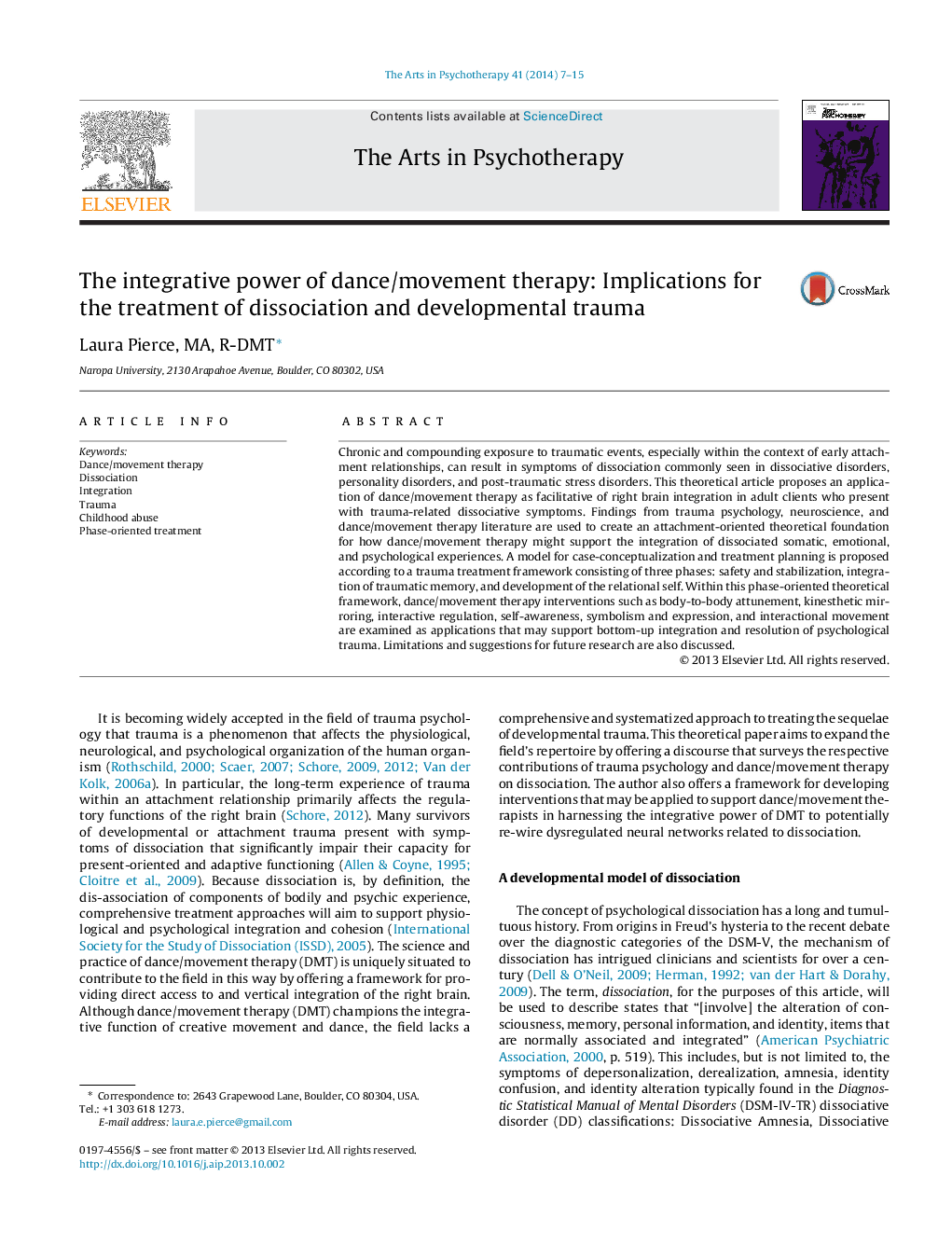| کد مقاله | کد نشریه | سال انتشار | مقاله انگلیسی | نسخه تمام متن |
|---|---|---|---|---|
| 10310315 | 617191 | 2014 | 9 صفحه PDF | دانلود رایگان |
عنوان انگلیسی مقاله ISI
The integrative power of dance/movement therapy: Implications for the treatment of dissociation and developmental trauma
ترجمه فارسی عنوان
قدرت یکپارچه سازی رقص / جنبش درمان: پیامدهای درمان اختلال و ترومای پیشرفت
دانلود مقاله + سفارش ترجمه
دانلود مقاله ISI انگلیسی
رایگان برای ایرانیان
کلمات کلیدی
رقص / حرکت درمان، انحلال، ادغام، تروما سوء استفاده از دوران کودکی، درمان فاز گرا
ترجمه چکیده
در معرض حوادث تروماتیک مزمن و ترکیبی، به خصوص در زمینه روابط دلبستگی اولیه، می تواند نشانه هایی از اختلال را که معمولا در اختلالات اختلالات، اختلالات شخصیتی و اختلالات استرس پس از سانحه مشاهده می شود، منجر شود. این مقاله تئوری پیشنهاد استفاده از حرکات رقص / حرکات را به عنوان یکپارچه سازی یکپارچگی مغز راست در افراد بالغ که با علائم غیرضروری مربوط به آسیب پذیری هستند، ارائه می دهد. یافته های مربوط به روانشناسی تروما، علوم اعصاب و رقص / جنبش درمانی برای ایجاد یک مبانی نظری دلبستگی جهت استفاده از تکنیک رقص / حرکات متحرک از ادغام تجربیات جسمی، احساسی و روحی جدا شده استفاده می شود. یک مدل برای مفهوم سازی حوادث و برنامه ریزی درمان بر اساس یک چارچوب درمان تروما که شامل سه مرحله است: ایمنی و تثبیت، ادغام حافظه آسیب پذیر و توسعه ارتباطی خود. در چارچوب چارچوب نظری فاز گرا، مداخلات رقص / جنبش درمانی از قبیل تنظیم بدن به بدن، معکوس جنبشی، تنظیم تعاملی، خودآگاهی، نمادگرایی و بیان و حرکت تعاملی به عنوان برنامه هایی که ممکن است از یکپارچگی پایین و حل و فصل از آسیب روانی. محدودیت ها و پیشنهادات برای تحقیقات آینده نیز مورد بحث قرار گرفته است.
موضوعات مرتبط
علوم پزشکی و سلامت
پزشکی و دندانپزشکی
روانپزشکی و بهداشت روانی
چکیده انگلیسی
Chronic and compounding exposure to traumatic events, especially within the context of early attachment relationships, can result in symptoms of dissociation commonly seen in dissociative disorders, personality disorders, and post-traumatic stress disorders. This theoretical article proposes an application of dance/movement therapy as facilitative of right brain integration in adult clients who present with trauma-related dissociative symptoms. Findings from trauma psychology, neuroscience, and dance/movement therapy literature are used to create an attachment-oriented theoretical foundation for how dance/movement therapy might support the integration of dissociated somatic, emotional, and psychological experiences. A model for case-conceptualization and treatment planning is proposed according to a trauma treatment framework consisting of three phases: safety and stabilization, integration of traumatic memory, and development of the relational self. Within this phase-oriented theoretical framework, dance/movement therapy interventions such as body-to-body attunement, kinesthetic mirroring, interactive regulation, self-awareness, symbolism and expression, and interactional movement are examined as applications that may support bottom-up integration and resolution of psychological trauma. Limitations and suggestions for future research are also discussed.
ناشر
Database: Elsevier - ScienceDirect (ساینس دایرکت)
Journal: The Arts in Psychotherapy - Volume 41, Issue 1, February 2014, Pages 7-15
Journal: The Arts in Psychotherapy - Volume 41, Issue 1, February 2014, Pages 7-15
نویسندگان
Laura MA, R-DMT,
